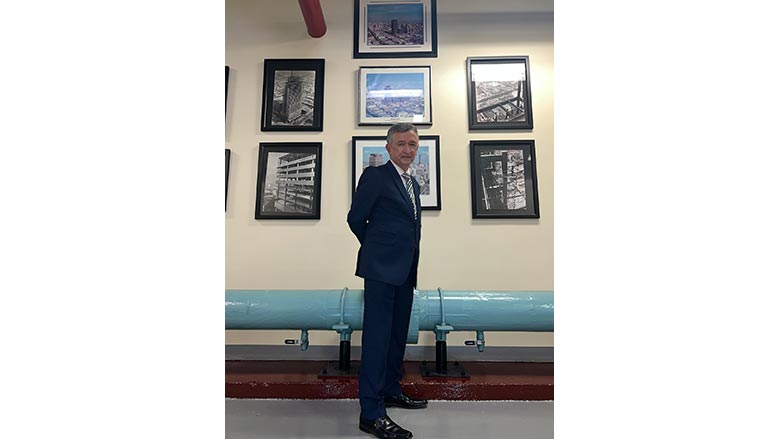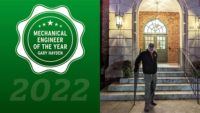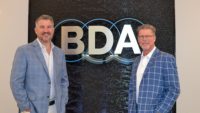Dr. Saum Nour (Khosrow Nourmohammadi), PE, Ph.D., CPD, LEED AP, CFPE, AIA Allied, is a very well-educated man. Just a quick glance at all the acronyms after his name may have some people feeling a bit intimidated. Indeed, the man has a bachelor’s degree in mechanical engineering, a bachelor’s, master’s and Ph.D. in nuclear engineering, is a licensed Professional Engineer in mechanical, electrical and civil engineering, is Certified in Plumbing Design and in Fire Protection Engineering and is an American Society of Plumbing Engineers Fellow to name a few of the many highlights on his resume. He is also licensed in 30 states and speaks three languages fluently while dabbling in others.
However, Nour himself is a self-described “Renaissance man” who loves talking to people from all walks and disciplines of life. He is very down-to-Earth, often cracking self-deprecating jokes and laughing at his own expense. His deep knowledge of the industry, constant pursuit of education and willingness to help others learn has nabbed him the award for PM Engineer’s 2022 Plumbing Engineer of the Year.
Early beginnings
One of the first things people notice about Dr. Nour is he only has one arm. He actually uses his condition to break the ice by telling bad one-arm or one-hand jokes to put people at ease.
“The Army wouldn’t take me because I cannot do hand-to-hand combat.”
“I cannot get arrested — how would they handcuff me?”
“They won’t let me use the phrase, ‘on the other hand,’ because I can’t.”
He’s got a ton of them, just ask him.
Nour was one of about 10,000 children born with severe defects in the 1950s and 1960s after pregnant mothers were given Thalidomide for the treatment of nausea and cramps. Nour has not let his disability color his outlook on life or slow him down.

Nour was one of about 10,000 children born with severe defects in the 1950s and 1960s after pregnant mothers were given Thalidomide for the treatment of nausea and cramps. He has not let his disability color his outlook on life or slow him down.
“I was lucky to have one hand because there are many who were born without hands or legs,” he explains. “But the beauty is that I can make ADA jokes and nobody can tell me to stop.”
Born in Iran, Nour’s journey to the U.S. began at age six, when he visited a place in Tehran to receive an artificial arm.
“The guy says, ‘When you get older, ours is not so good. Go to the United States and get one there,’” Nour says. “So when I was 13 years old, my brother said if we come to the United States and take a test, I could maybe finish high school in one year. By the time I was 15, I graduated from Western Heights High School in Oklahoma City.”
What followed afterward was a whirlwind of studying and degrees for Nour. After graduation, he traveled the world, spending time in Japan before returning to Iran where he met his wife. Once married, they lived in Germany for a short time before returning to the United States.
“At that time, it was all ‘Star Wars’ and Ronald Reagan, and the research literally had dried up,” Nour explains. “I was not a U.S. citizen, so I couldn’t get a job, so I started from scratch. I literally started drafting — plumbing and mechanical drafting for a one-man office. I finally got into mechanical and took my PE in 1988 and passed. I started my company, Absolute Consulting Engineers in 1987 with the help of another PE.

In addition to his consulting work, Nour is also a professor and lecturer, having taught at several schools and universities.
“Between all the trades, I found that plumbing was the one that really, really needed the help,” he continues. “In regards to other industries, plumbing still needs a lot of help today.”
In addition to his consulting work, Nour also is a professor and lecturer who has taught at several different schools and universities, and is an approved CEU provider for AIA. He has also completed much LEED and CALGreen work.
“I found out because I’m handicapped, they asked me to teach ADA,” Nour says. “So for the past eight to nine years, I've been teaching ADA programs. What is funny is that in order for you to renew your license with NCARB, you have to have five hours of ADA and that's what I teach. Also, in the past decade, I have taught all six Architectural Registration Exam classes at USC School of Architecture for the ‘Not Yet Licensed Program.’ Because being a nerd, all the jobs nobody wants come to me. Because of that, I also do a lot of litigations. If I know that they're going for litigation only for the purpose of lawsuits, I walk away. I've seen animosities and I walk away. Right now, I have a case that has to deal with plastic but I can’t go into details with you. The last one was with shower heads, believe it or not. I actually made models of shower heads. I scared the opponents so badly, they didn't want to go to court. I’m only 5’6”, but they got scared.”
Nour explains the biggest problem facing eningeers right now is they don’t understand engineering principles.
“They see it as a cookbook — plumbing engineering has become a cookbook,” he says. “They don’t understand what the fluid does. It’s like math. When you teach math, it doesn’t leave the brain because you understand it. Once you feel it, it doesn't dissipate. That's the part to me that makes sense. You work 16 hours a day, and I can tell you how many seconds are in 16 hours. It’s very simple. Every second counts and those are given. It literally goes back to the zeros and ones of the movie ‘The Matrix.’ It’s the building block. For example, in court, as soon as the guy brings up the question, I know where he’s going. You put all those zeros and ones together. To me, it’s all about whether or not you feel it. That’s how I was able to teach my kids English, science and math. For them to feel it, not just memorize it. I hate memorizing.”
Passion for the industry
Nour notes that he loves his job — it’s far better than Netflix.
“First of all, I didn’t think I would make this much money,” he jokes. “They actually pay you for what you do! The second part is all sciences are actually one. It has nothing to do with plumbing and civil engineering, etc. When you look at pressure dynamics or the hydrodynamic of a box in a pool, it’s the same as pressure in a structure. I've written many sections and lectures on acoustics and on difference between a light for lighting sounds and a nuclear radiation. They all use the same equation. What I like is the fact that I can fuse them together, and that's the beauty of it.”
“Between all the trades, I found that plumbing was the one that really, really needed the help. In regards to other industries, plumbing still needs a lot of help today.”
Nour is somewhat of a perpetual student. Though he only needs 30 hours of continuing professional education every two years, he obtains more than 150 CEUs.
“I like to find out what I don’t know,” he says. “Every time the economy took a turn, I picked up another license. When one economy went bad, I became an electrical engineer. Another one was civil/structural. Then, I became LEED AP, and CALGreen blogger. Right now, believe it or not, I passed LEED GA, and I'm studying to be LEED AP O+M because my LEED AP Legacy vanished and dissipated. It's very hard to study at 64. I had to keep drinking tea to energize my cells.”
If you ask him to point to the biggest challenge facing the industry, Nour immediately points to water conservation and climate change.
“I’ve got to tell you if the whole plumbing industry doesn’t come up with a solution, we’re going to have a problem,” he says. “Everyone’s more intrigued by the bodies found in Lake Mead than in the 25-foot reduction in water and the death of millions of species. Nobody is talking about water. Most organizations will do little showcases for posters, and when green and LEED came up, everyone had a little green leaf symbol on their cards. Now, it’s all gone. But it’s coming back. It’s very sad. This is going to be a challenge for engineers for years to come.”
As with most things, Nour points out the answer starts with education.
“Australia lives with 30-40 gallons of water per day per person while the United States is 120 to 140 gallons per day per person. Pretty soon, all the green golf courses will be sand. I had a guy building a 4,000-square-foot house in California call me. In California, you can only have 2.5 gpm coming out of your shower, but this guy wants 15 shower heads on it. That’s part of the problem. People think they can do what they want because they have money. Engineers need to live in these water scarce places like Australia or Jordan. Because the issue is we are going to be in that boat very soon. The inevitable and undeniable is here. Farmers need water, and power plants need water so the electricity can come to your house so you can watch Netflix.”
Nour dismisses the growing decarbonization and electrification movement, saying the issue with droughts and water conservation are much more immediate.
“If I leave you and three individuals with a shelf of items and say you are supposed to walk for four hours through the desert, the only item you’re choosing is water. Not a TV, not an accordion or trumpet. Just water — the most critical element there is. If we put everyone into a box and simply say, ‘Please understand that you have no water,’ I guarantee every plumbing engineer inside their garage will create something new to solve this issue. We need to take the clock back and assume this is ground zero. There is no water. How can we all become Arizona overnight?”
High regards
Sal Salehi of San Diego-based Salehi-Salehi Engineering, has worked with Nour for nearly 27 years.
“We met through a project and there was an instant rapport between him and I,” Salehi notes. “I have a tremendous amount of respect for his knowledge because he knows how to interpret the code, and more importantly than anything else, how to apply it to the projects. He’s also strong academically. Graduating from the University of Illinois Urbana-Champaign is no joke. He just knows how to relay the messages to the architects or inspectors in a way they understand. I’ve learned a lot from him over the years.”
According to Los Angeles Architect Pierluigi Bonvicini, he and Nour started working together about 15 years ago and have been inseparable ever since.
“I was looking for an MEP firm that could partner with me in all my high-end retail projects across the U.S.,” Bonvicini says. “Saum is quite a brilliant engineer, always ready to take on a new challenge. His experience ranges over a very broad spectrum of engineering fields. He can look at things from different angles and he is always able to devise clever and unique solutions. Saum is also expert and lecturer on ADA accessibility requirements, the Green Code and LEED certifications. His professional standards are very high. I am thrilled that I can count on him and his dedicated engineering team to meet our generally tough deadlines.”
Bonvicini adds that Nour is relentlessly passionate about life and completely devoted to his family and work.
“There seems to be nothing that he would not be ready to tackle but, more importantly, he is always smiling and ready to crack a joke,” he says. “God knows how many times we have found ourselves engaged in conversations about philosophy and history, or some other interesting facts he had just read about at 4 a.m. that morning.”
Pete DeMarco, executive vice president of advocacy and research at IAPMO, notes that he was virtually introduced to Nour by past IAPMO CEO Russ Chaney.
“I remember Russ telling me ‘You’re going to really enjoy working with Saum. He’s a remarkable person,’” he says. “As usual, Russ was right. There are three things that make him a fascinating individual. One, he’s a an incredibly learned man, not only in the plumbing and mechanical sciences, but in all aspects of life. He has incredible empathy for people. Second is his personality and sense of humor. When you first meet Saum, you immediately know that you’ll never forget him. His laugh is infectious. And, third is his reputation as a great teacher. I never had the benefit of attending one of Saum’s seminars or educational sessions, but I’ve lost count of how many people have told me that they attended an IAPMO Chapter meeting where Saum presented and just raved about how great he was and how much they learned. He really has a wonderful way of connecting with people.
“My experience in working with Saum has been limited to plumbing and mechanical code issues,” DeMarco adds. “Saum has a very interesting way of getting to the heart of an issue, always with an antidote or two to drive home a point, and considering it from multiple perspectives.”
A grain of salt
Engineers need to look at the things systematically, Nour explains.
“The problem is engineers are monotonic — they take whatever the vendor says and believe it as gospel. They don't see it in three dimensions, maybe all dimensions. That's the challenge. Engineers have no understanding of electronics and everything is becoming super electronic. Merging all these technologies together, the engineer is accepting whatever the vendor says. The vendor is sucking up whatever the manufacturer says. There is no understanding of the whole integrated concept. There is no systems thinking, there's no integrated concept. Things go wrong and they don't know why.”
He encourages not only engineers, but manufacturers to start thinking holistically, instead of just brining products and technologies from Europe over to the U.S.
“They don’t think about the entire system — they don’t think holistically,” he says. “The industry needs to rethink when it produces a product. The beauty of LEED is that every part of the building is involved — from the cooling tower to the chiller to the electrical to the facility maintenance — that’s called holistic. That just isn’t done in plumbing. And we need more of that approach.”
Advice for future generations
Nour notes he advises all aspiring engineers to take the time to really understand the principles of engineering.
“As an immigrant, our choices are to become a lawyer, physician or an engineer. As a person who is born in Iran, you become an engineer by heart because you really want to. In every lecture, I say, ‘Please don’t look at engineering as a job so you can buy your Porsche.’ Buying a Porsche is OK, but before you do that, you have to understand the equation, understand the concept. Look at it like math. The integral is the area under the curve. Area under the curve means that there are all these infinitesimal components you pick up from that curve, and you add them up and it becomes integral and becomes the area under the curve. I simply say learn every one of those epsilons — epsilon is smallest piece of that. Learn it by heart and feel it. Once you take the area under the curve — that engineering — and integrate all that into your brain, you will love it. You become proud of it and they don't call you ‘nerd’ anymore. That's the beauty. Once you know it, they will actually pay you for what you know, and they pay you handsomely and you can buy two Porsches.”
He also highly recommends joining professional associations like the American Society of Plumbing Engineers (ASPE).
“I hate to use a handicapped metaphor, but I will because I can,” Nour says. “A blind person without a cane cannot go anywhere. That cane technically tells you within four or five feet of you, what's happening. Using your ears as a sensing device, you know a car is coming. When you become an ASPE member, you realize what's next — especially at the conventions. If you don't go, you don't know.”
In the end, Nour hopes he has helped make some small difference in the industry.
“When I go, I pray I will be leaving a ton of YouTube material behind to show I have done something in the industry, he says. “That's the only impact that I want to leave. That's why, when I teach, I believe I'm giving something. That's my prayer. That's why anybody who calls me for any question, I have no hesitation to respond. Even if it is my next door neighbor in a competition, it doesn't matter. We are like water, and you are supposed to evaporate, give vapor and we'll come back as water. You're supposed to follow the cycle.”




